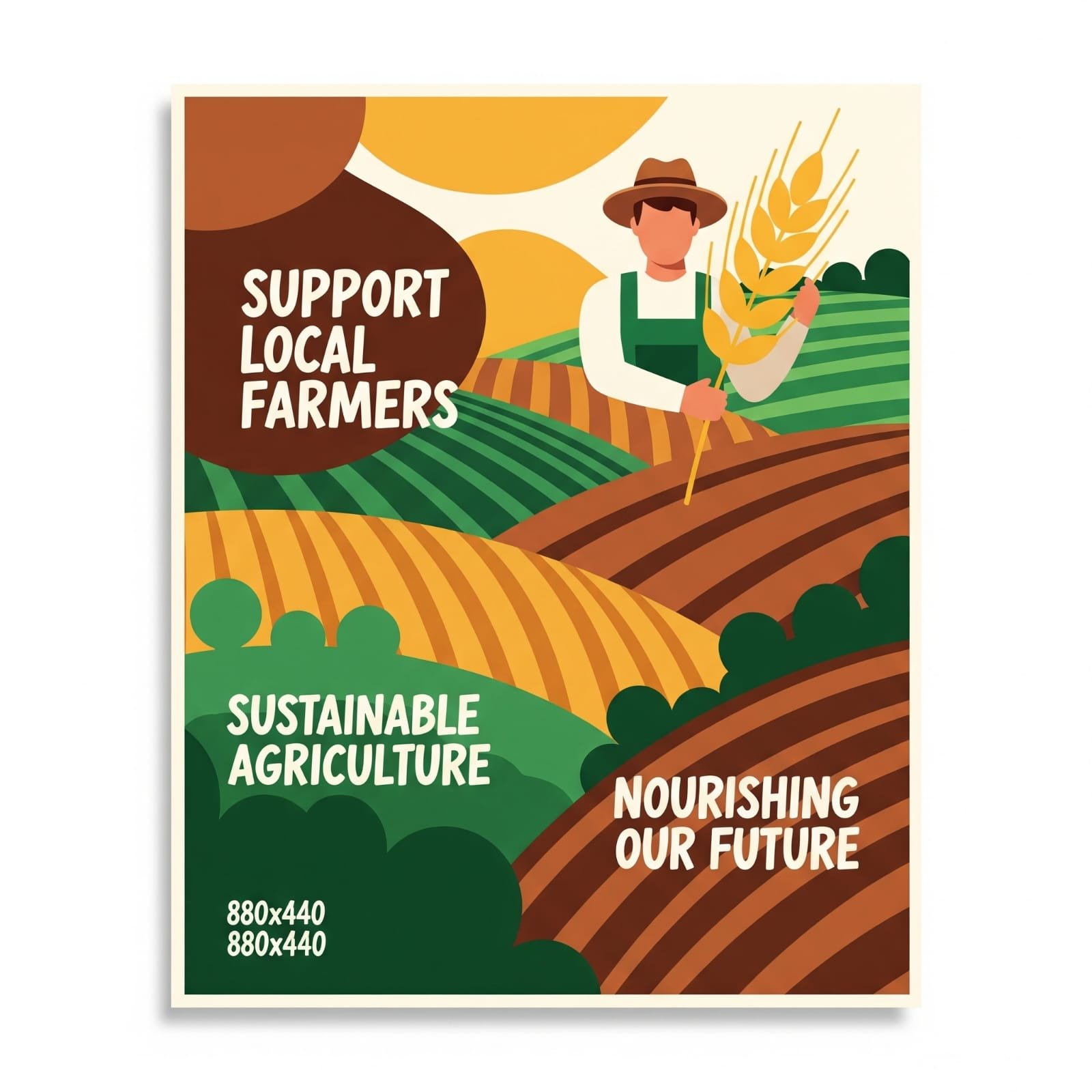
Sustainable Agriculture: The Path Towards a Resilient Future
Agriculture has always been the foundation of human civilization, providing the food, raw materials, and economic stability needed for societies to thrive. However, as the global population increases and environmental challenges intensify, traditional agricultural practices face mounting pressure. Sustainable agriculture emerges as a dynamic solution, promising to secure food production while protecting natural resources and improving the livelihoods of farmers around the world.
Understanding Sustainable Agriculture
At its core, sustainable agriculture is an approach to farming that seeks to balance the need for food production with environmental conservation and social equity. It is a system that not only looks at current productivity but is also forward-thinking, ensuring that the land and resources remain fertile and productive for future generations. This approach encompasses a range of practices designed to reduce the harmful impacts of agriculture, such as soil degradation, water pollution, and biodiversity loss.
Sustainable agriculture does not solely rely on synthetic chemicals like fertilizers and pesticides; instead, it emphasizes natural processes and ecological balance. Key principles include conserving water and soil, utilizing renewable resources, and integrating diversified farm practices to enhance ecosystem resilience. By promoting a closed-loop system where waste is minimized and resources are recycled, sustainable agriculture aims to create a harmonious relationship between nature and human activity.
The Challenges Facing Modern Agriculture
Modern agricultural practices, though successful in producing higher yields, have often come at a significant cost to the environment. Intensive farming has led to severe soil erosion and nutrient depletion, making farmlands less productive over time. The widespread use of chemical pesticides and fertilizers has not only contaminated water sources but also disrupted local ecosystems by harming beneficial insects and wildlife. Climate change further exacerbates these issues, as unpredictable weather patterns and extreme events undermine the reliability of traditional farming methods.
Moreover, traditional methods frequently prioritize short-term gains at the expense of long-term sustainability. The focus on monoculture—growing a single crop over large expanses of land—reduces biodiversity and increases vulnerability to diseases and pests. The resulting agricultural practices have led many to question if the current system is truly viable in the face of global environmental challenges and population growth.
Key Practices in Sustainable Agriculture
To overcome these challenges, sustainable agriculture employs several innovative practices:
Organic Farming: Organic farming avoids synthetic chemicals and fertilizers, instead relying on natural methods such as composting, crop rotation, and biological pest control. This approach not only improves the health of the soil but also reduces the risk of chemical residues in food products.
Integrated Pest Management (IPM): IPM is a strategy that focuses on managing pests through a combination of biological control, cultural practices, and minimal chemical interventions. By using natural predators, crop diversity, and carefully monitored chemical applications, farmers can maintain pest populations at manageable levels while preserving ecological balance.
Agroforestry: This practice integrates trees and shrubs into crop and livestock farming systems, fostering biodiversity, enhancing soil structure, and improving water retention. Trees act as windbreaks, provide shade, and contribute organic matter to the soil, which in turn supports crop health.
Conservation Tillage: Reducing the frequency and intensity of tilling helps to maintain soil structure and moisture, reduces erosion, and supports the natural communities of microorganisms in the soil. Techniques such as no-till farming have gained popularity among sustainable agriculture advocates due to their long-term benefits.
Water Conservation Techniques: Methods like drip irrigation, rainwater harvesting, and mulching help conserve water—a critical resource in many agricultural regions. By targeting water delivery and reducing evaporation, these techniques ensure that crops receive the right amount of moisture while minimizing waste.
Diversified Farming Systems: Rather than relying on monoculture, diversified farming incorporates multiple crops and livestock. This not only spreads risk but also improves soil fertility as different species contribute various nutrients to the ecosystem, creating a more resilient agricultural system.
Economic and Social Benefits
Beyond environmental advantages, sustainable agriculture also promotes economic stability and social welfare. By reducing dependency on expensive chemical inputs and fossil fuels, sustainable methods can lower the cost of production. Small-scale farmers, in particular, benefit from organic practices as these methods often require less capital investment and provide access to premium markets that value eco-friendly and ethically produced products.
Moreover, sustainable agriculture emphasizes community engagement and the transfer of traditional knowledge. Many sustainable practices are rooted in centuries-old traditions passed down through generations, blending cultural heritage with modern science. Empowering local communities to manage their resources sustainably not only secures food production but also fosters social cohesion and strengthens local economies.
The Role of Technology and Innovation
Technology has an increasingly significant role in promoting sustainable agriculture. Precision farming, for instance, utilizes data analytics, satellite imagery, and GPS mapping to monitor crop health and optimize resource use. This allows farmers to apply water, fertilizers, and pesticides precisely where needed, reducing waste and environmental impact. Furthermore, advancements in biotechnology have paved the way for crop varieties that are more resistant to pests and environmental stresses, reducing the necessity for chemical interventions.
Innovations in renewable energy, such as solar-powered irrigation systems and wind-driven machinery, further support sustainable practices. These technologies not only reduce the carbon footprint of agricultural operations but also help farmers in remote areas who might otherwise struggle with limited access to traditional power sources.
Policy and Community Support
Achieving sustainable agriculture on a large scale requires supportive policies and robust community engagement. Governments play a crucial role by crafting policies that incentivize sustainable practices, such as subsidies for organic farming, grants for renewable energy projects, and education programs that train farmers in modern, sustainable methods. International cooperation is also vital, with global organizations and NGOs working to fund research and share best practices across borders.
Community-supported agriculture (CSA) is one example of how grassroots movements can drive change. By connecting consumers directly with local farmers, CSAs not only secure a market for sustainably produced food but also raise awareness about the importance of environmental stewardship and ethical farming.
Looking Forward
The future of agriculture depends on our ability to innovate and adapt. Sustainable agriculture offers a comprehensive framework that addresses the multifaceted challenges of modern food production. As the world grapples with the consequences of climate change, land degradation, and resource scarcity, adopting sustainable practices is not simply a choice—it is a necessity.
Investing in research and development is crucial, as is educating new generations of farmers on sustainable methods and technologies. Collaborative efforts between governments, communities, and the private sector will help create a resilient agricultural system that can withstand future challenges while ensuring that every individual has access to nutritious food.
In conclusion, sustainable agriculture provides a balanced and forward-thinking approach to addressing the pressing issues of our time. By harmonizing the relationship between humans and nature, it paves the way for a future where food security, environmental protection, and economic prosperity go hand in hand. This integrated model not only safeguards the well-being of current populations but also lays the foundation for a healthier, more resilient planet for generations to come.
This essay discusses the importance of sustainable agriculture, outlining its principles, practices, and benefits. It emphasizes the need for innovation and collective action in ensuring that agricultural practices can sustainably support growing global demands while protecting our natural resources.
